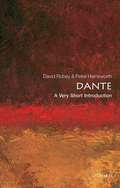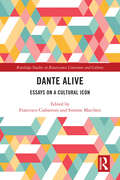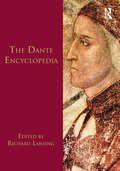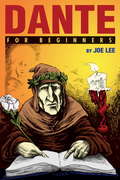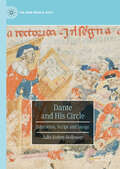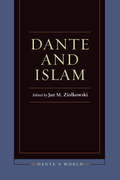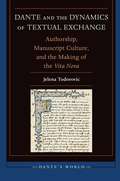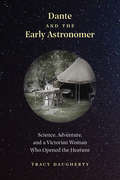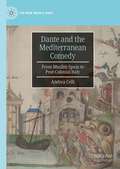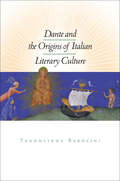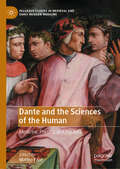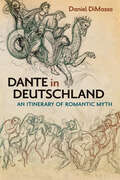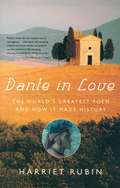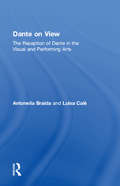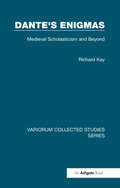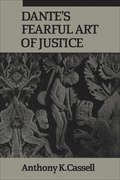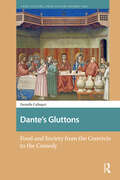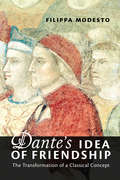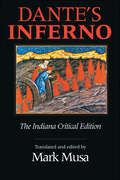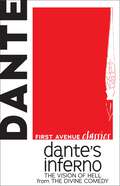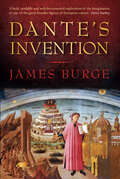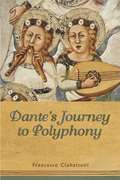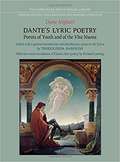- Table View
- List View
Dante (A Very Short Introduction)
by Peter Hainsworth; David RobeyThey emphasise the distinctive and dynamic interplay in Dante's writing between argument, ideas, and analysis on the one hand, and poetic imagination on the other.Dante was highly concerned with the political and intellectual issues of his time, demonstrated most powerfully in his notorious work, The Divine Comedy. Tracing the tension between the medieval and modern aspects, Hainsworth and Robey provide a clear insight into the meaning of this masterpiece of world literature.
Dante Alive: Essays on a Cultural Icon (Routledge Studies in Renaissance Literature and Culture)
by Francesco Ciabattoni and Simone MarchesiThe essays collected here join in, and contribute to, the current reflection on Dante’s vitality today in a critical, multidisciplinary vein. Their intervention comes at a particularly sensitive juncture in the history of Dante’s global reception and cultural reuse. Dante today is as alive as ever. A cultural icon no less than a cultural product, Dante’s imaginative universe enjoys a pervasive presence in popular culture. The multiformity of approaches represented in the collection matches the variety of the material that is analyzed. The volume documents Dante’s presence in genres as different as graphic novels and theater productions, children’s literature, advertisements and sci-fi narratives, rock and rap music, video- and boardgames, satirical vignettes and political speeches, school curricula and prison-teaching initiatives. Each essay combines a focused attention to the specificity of the body of evidence it treats with best analytical practices. The volume invites collective reflection on the many different rules of engagement with Dante’s text
Dante Encyclopedia
by Richard LansingAvailable for the first time in paperback, this essential resource presents a systematic introduction to Dante's life and works, his cultural context and intellectual legacy.The only such work available in English, this Encyclopedia:brings together contemporary theories on Dante, summarizing them in clear and vivid prose provides in-depth discussions of the Divine Comedy, looking at title and form, moral structure, allegory and realism, manuscript tradition, and also taking account of the various editions of the work over the centuries contains numerous entries on Dante's other important writings and on the major subjects covered within them addresses connections between Dante and philosophy, theology, poetics, art, psychology, science, and music as well as critical perspective across the ages, from Dante's first critics to the present.
Dante For Beginners
by Joe LeeDante For Beginners takes the reader on a magical trip through Heaven and Hell. Well, this isn't exactly true. After an introduction to Dante Alighieri and his background, the reader meets a sweet lass named Beatrice, the love of his life and the subject of many of his poems. Then the reader explores other samples of Dante's works, such as the great feast, the Convivio. The reader is ultimately led through Dante's most famous and challenging masterpiece, the Commedia, also known as the Divine Comedy, with a canto by canto description of the entire text from Heaven to Hell. Characters, ideas and situations are described as they happen without the need to search through end notes or footnotes to understand the text. Dante For Beginners is a vacation through great Italian literature with history's greatest guide, Dante Alighieri.
Dante and His Circle: Education, Script and Image (The New Middle Ages)
by Julia Bolton HollowayIn this book, Julia Bolton Holloway makes use of primary materials in documents, manuscripts and stone monuments in Florence, to place Dante's literary career in its rich context. Dante and His Circle discusses the encyclopaedic multicultural education in classical literature, law, ethics, rhetoric, diplomacy, poetry, music and cosmology Brunetto Latino gave to Guido Cavalcante, Dante Alighieri and Francesco da Barberino. Bolton Holloway traces Latino’s use of Arabic methods he had learned at the Court of Alfonso X el Sabio in Spain in 1260. Next Latino dictates his 'Rettorica', 'Tesoretto' and 'Tesoro' in Italian to his students, following the Sicilian Vespers, the manuscripts of their circle later coming to be re-edited, illustrated and published by Dante's fellow student, Francesco da Barberino, who survived them all and who likewise copied Alfonsine methods for producing the 'Danti del Cento' manuscripts of the 'Commedia'. The book ends by discussing Dante's Decolonialism. Each chapter provides Study Questions for further research.
Dante and Islam (Dante's World: Historicizing Literary Cultures of the Due and Trecento)
by Jan M. ZiolkowskiDante put Muhammad in one of the lowest circles of Hell. At the same time, the medieval Christian poet placed several Islamic philosophers much more honorably in Limbo. Furthermore, it has long been suggested that for much of the basic framework of the Divine Comedy Dante was indebted to apocryphal traditions about a “night journey” taken by Muhammad.Dante scholars have increasingly returned to the question of Islam to explore the often surprising encounters among religious traditions that the Middle Ages afforded. This collection of essays works through what was known of the Qur’an and of Islamic philosophy and science in Dante’s day and explores the bases for Dante’s images of Muhammad and Ali. It further compels us to look at key instances of engagement among Muslims, Jews, and Christians.
Dante and the Dynamics of Textual Exchange: Authorship, Manuscript Culture, and the Making of the 'Vita Nova' (Dante's World: Historicizing Literary Cultures of the Due and Trecento)
by Jelena TodorovićDante and the Dynamics of Textual Exchange is the first book-length study to explore the question of poetry and genre in Dante’s Vita Nova (ca. 1292–1294). In paying particular attention to complex and multifaceted interactions between different cultures in Italy in the thirteenth century, this study illuminates the multicultural and plurilinguistic society transitioning from the feudal court to the modern city-state, advanced by the rising mercantile class. Working at the intersection of textual, material, and cultural elements, this study complements the current state of scholarship by providing information and answers informed by an in-depth analysis of the manuscript culture and its role in the birth and development of European vernacular traditions. Furthermore, Dante and the Dynamics of Textual Exchange expands the literature’s understanding of the dynamics between a text and its material support by looking at this relationship within a broader framework of intercultural exchange, which suggests an increased dynamics and fluidity between cultures.
Dante and the Early Astronomer: Science, Adventure, and a Victorian Woman Who Opened the Heavens
by Tracy DaughertyExplore the evolution of astronomy from Dante to Einstein, as seen through the eyes of trailblazing Victorian astronomer Mary Acworth Evershed In 1910, Mary Acworth Evershed (1867–1949) sat on a hill in southern India staring at the moon as she grappled with apparent mistakes in Dante’s Divine Comedy. Was Dante’s astronomy unintelligible? Or was he, for a man of his time and place, as insightful as one could be about the sky? As the twentieth century began, women who wished to become professional astronomers faced difficult cultural barriers, but Evershed joined the British Astronomical Association and, from an Indian observatory, became an experienced observer of sunspots, solar eclipses, and variable stars. From the perspective of one remarkable amateur astronomer, readers will see how ideas developed during Galileo’s time evolved or were discarded in Newtonian conceptions of the cosmos and then recast in Einstein’s theories. The result is a book about the history of science but also a poetic meditation on literature, science, and the evolution of ideas.
Dante and the Mediterranean Comedy: From Muslim Spain to Post-Colonial Italy (The New Middle Ages)
by Andrea CelliIn recent decades the concept of Mediterranean has been cited with increasing frequency in relation to the study of medieval literatures. And yet, in what sense would Dante’s Comedy be ‘Mediterranean’? Is it because of its Greek-Arabic and Islamic sources? Dante and the Mediterranean Comedy analyzes the ideological function of references to the sea in the study of the Comedy undertaken by Enrico Cerulli, a scholar of Somali-Ethiopian languages, and a colonial governor of ‘Italian East Africa.’ Then it presents novel lines of inquiry on the reception and appropriation of the poem, such as the presence of Islamic sources in early commentaries of the Comedy, and cross-cultural allusions to Dante’s Hell in some graffiti on the walls of the Spanish Inquisition prison in Palermo. The image of the Mediterranean that seeps through the poem and through the history of its circulation is vivid yet hardly idyllic.
Dante and the Origins of Italian Literary Culture
by Teodolinda BaroliniIn this book, Teodolinda Barolini explores the sources of Italian literary culture in the figures of its lyric poets and its “three crowns”: Dante, Petrarch, and Boccaccio. Barolini views the origins of Italian literary culture through four prisms: the ideological/philosophical, the intertextual/multicultural, the structural/formal, and the social.The essays in the first section treat the ideology of love and desire from the early lyric tradition to the Inferno and its antecedents in philosophy and theology. In the second, Barolini focuses on Dante as heir to both the Christian visionary and the classical pagan traditions (with emphasis on Vergil and Ovid). The essays in the third part analyze the narrative character of Dante’s Vita nuova, Petrarch’s lyric sequence, and Boccaccio’s Decameron. Barolini also looks at the cultural implications of the editorial history of Dante’s rime and at what sparso versus organico spells in the Italian imaginary. In the section on gender, she argues that the didactic texts intended for women’s use and instruction, as explored by Guittone, Dante, and Boccaccio—but not by Petrarch—were more progressive than the courtly style for which the Italian tradition is celebrated.Moving from the lyric origins of the Divine Comedy in “Dante and the Lyric Past” to Petrarch’s regressive stance on gender in “Notes toward a Gendered History of Italian Literature”—and encompassing, among others, Giacomo da Lentini, Guido Cavalcanti, and Guittone d’Arezzo—these sixteen essays by one of our leading critics frame the literary culture of thirteenth-and fourteenth-century Italy in fresh, illuminating ways that will prove useful and instructive to students and scholars alike.
Dante and the Sciences of the Human: Medicine, Physics, and the Soul (Palgrave Studies in Medieval and Early Modern Medicine)
by Matteo PaceThis edited collection explores Dante Alighieri’s contribution to medical, scientific, and spiritual thought in medieval and early modern times. The chapters address how Dante shaped an understanding of the human body and mind, his relationship with medical and scientific thought in his literary and philosophical production, and his legacy which continued into the following centuries. Each chapter questions Dante’s contribution to these issues from an interdisciplinary perspective, thus putting medieval literatures in conversation with the history of medicine and science, politics, theology, and philosophy. Covering questions on the body, soul, matter, politics, and physics, this valuable book presents an overview of Dante’s relationship with medical thought and the medieval sciences.
Dante in Context
by Zygmunt G. BarańskiIn the past seven centuries Dante has become world renowned, with his works translated into multiple languages and read by people of all ages and cultural backgrounds. This volume brings together interdisciplinary essays by leading, international scholars to provide a comprehensive account of the historical, cultural and intellectual context in which Dante lived and worked: from the economic, social and political scene to the feel of daily life; from education and religion to the administration of justice; from medicine to philosophy and science; from classical antiquity to popular culture; and from the dramatic transformation of urban spaces to the explosion of visual arts and music. This book, while locating Dante in relation to each of these topics, offers readers a clear and reliable idea of what life was like for Dante as an outstanding poet and intellectual in the Italy of the late Middle Ages.
Dante in Deutschland: An Itinerary of Romantic Myth (New Studies in the Age of Goethe)
by Daniel DiMassaAround the turn of the nineteenth century, no task seemed more urgent to German Romantics than the creation of a new mythology. It would unite modern poets and grant them common ground, and bring philosophers and the Volk closer together. But what would a new mythology look like? Only one model sufficed, according to Friedrich Schlegel: Dante’s Divine Comedy. Through reading and juxtaposing canonical and obscure texts, Dante in Deutschland shows how Dante’s work shaped the development of German Romanticism; it argues, all the while, that the weight of Dante’s influence induced a Romantic preoccupation with authority: Who was authorized to create a mythology? This question—traced across texts by Schelling, Novalis, and Goethe—begets a Neo-Romantic fixation with Dantean authority in the mythic ventures of Gerhart Hauptmann, Rudolf Borchardt, and Stefan George. Only in Thomas Mann’s novels, DiMassa asserts, is the Romantics’ Dantean project ultimately demythologized.
Dante in Love: The World's Greatest Poem and How It Made History
by Harriet RubinDante in Love is the story of the most famous journey in literature. Dante Alighieri, exiled from his home in Florence, a fugitive from justice, followed a road in 1302 that took him first to the labyrinths of hell then up the healing mountain of purgatory, and finally to paradise. He found a vision and a language that made him immortal. Author Harriet Rubin follows Dante's path along the old Jubilee routes that linked monasteries and all roads to Rome. It is a path followed by generations of seekers -- from T. S. Eliot, Sigmund Freud, Primo Levi, to Bruce Springsteen. After the poet fled Rome for Siena he walked along the upper Arno, past La Verna, to Bibiena, to Cesena, and to the Po plain. During his nineteen-year journey Dante wrote his "unfathomable heart song," as Thomas Carlyle called The Divine Comedy, a poem that explores the three states of the psyche. Eliot, a lifelong student of the Comedy, said, "Dante and Shakespeare divide the modern world between them, there is no third. "Dante in Love tells the story of the High Middle Ages, a time during which the artist Giotto was the first to paint the sky blue, Francis of Assisi discovered knowledge in humility and the great doctors of the church mapped the soul and stood back to admire their cathedrals. Dante's medieval world gave birth to the foundation of modern art, faith and commerce. Dante and his fellow artists were trying to decode God's art and in so doing unravel the double helix of creativity. We meet the painters, church builders and pilgrims from Florence to Rome to Venice and Verona who made the roads the center of the medieval world. Following Dante's route, we are inspired to undertake journeys of discovering ourselves. In the vein of Brunelleschi's Dome, Galileo's Daughter and Wittgenstein's Poker, Dante in Love is a worldly and spiritual travelogue of the poet's travels and the journey of creativity that produced the greatest poem ever written.
Dante on View: The Reception of Dante in the Visual and Performing Arts
by Antonella Braida Luisa CalèDante on View opens an important new dimension in Dante studies: for the first time a collection of essays analyses the presence of the Italian Medieval poet Dante Alighieri in the visual and performing arts from the Middle Ages to the present day. The essays in this volume explore the image of Dante emerging in medieval illuminated manuscripts and later ideological and nostalgic uses of the poet. The volume also demonstrates the rich diversity of projects inspired by the Commedia both as an overall polysemic structure and as a repository of scenes, which generate a repertoire for painters, actors and film-makers. In its original multimediality, Dante's Commedia stimulates the performance of readers and artists working in different media from manuscript to stage, from ballet to hyperinstruments, from film to television. Through such a variety of media, the reception of Dante in the visual and performing arts enriches our understanding of the poet and of the arts represented at key moments of formal and structural change in the European cultural world.
Dante's Divine Comedy: A Biography
by Joseph LuzziThe life and times of Dante&’s soaring poetic allegory of the soul&’s redemptive journey toward GodWritten during his exile from Florence in the early 1300s, Dante Alighieri&’s Divine Comedy describes the poet&’s travels through hell, purgatory, and paradise, exploring the state of the human soul after death. His poema sacro, sacred poem, profoundly influenced Renaissance writers and artists such as Giovanni Boccaccio and Sandro Botticelli and was venerated by modern critics including Erich Auerbach and Harold Bloom. Dante&’s &“Divine Comedy&” narrates the remarkable reception of Dante&’s masterpiece, one of the most consequential religious books ever written.Tracing the many afterlives of Dante&’s epic poem, Joseph Luzzi shows how it left its mark on the work of such legendary authors as John Milton, Mary Shelley, and James Joyce while serving as a source of inspiration for writers like Primo Levi and Antonio Gramsci as they faced the most extreme forms of political oppression. He charts how the dialogue between religious and secular ideas in The Divine Comedy has shaped issues ranging from changing conceptions of women&’s identity and debates about censorship to the role of canonical literature in popular culture.An intimate portrait of a work that has challenged and inspired generations of readers, Dante&’s &“Divine Comedy&” reveals how Dante&’s strikingly original and controversial vision of the afterlife can help us define our spiritual beliefs, better understand ourselves, and navigate the complexities of modern life.
Dante's Enigmas: Medieval Scholasticism and Beyond (Variorum Collected Studies)
by Richard KayDante's Comedy is a puzzling poem because the author wanted to lead his readers to understanding by engaging their curiosity. While many obscure matters are clarified in the course of the poem itself, others have remained enigmas that have fascinated Dantists for centuries. Over the last thirty-five years, Richard Kay has proposed original solutions to many of these puzzles; these are collected in the present volume. Historical context frames Kay's readings, which relate the poem to such standard sources as the Bible, Aristotle, Aquinas, and the Latin classics, but he also goes beyond these Scholastic sources to exploit Dante's use of less familiar aspects of Latin clerical culture, including physiognomy, Vitruvian proportions, and optics, and most especially astrology. Kay explores new ways to read the Comedy. For instance, he argues that Dante has embedded references to his authorities in a continuous series of acrostics formed by the initial letters of each tercet. Again, he shows how Dante returns to the theme of each infernal canto and develops it in the parallel cantos of Purgatorio and Paradiso. Particularly worthy of note are four essays on the poem's finale in the Empyrean.
Dante's Fearful Art of Justice
by Anthony CassellDante's Fearful Art of Justice deals primarily with the symbolic significance of 'the state of souls after death' in various episodes of the Inferno, the first canticle of Dante's Divina Commedia. The fruitlessness of the Auerbach-Singleton approach to the poem is demonstrated by Professor Cassell's investigations, which are based on the belief that Dante used both the theological system of fourfold allegory and the preconfiguration-fulfilment pattern of history found in the Old and New Testaments. The author first deals with the history of contrapassum, 'just retribution,' as it appeared in philosophy and theology, and describes Dante's use of historical and artistic figuration, both classical and Christian. It is central to Cassell's aim to show how Dante believed that his portrayal of the damned revealed the justice of God. Critics have believed that the relation of sin to the suffering of the shades in Hell was tenuous or even arbitrary in many cases. Cassell shows, through a close examination of Dante's assimilation of the Classics (and their medieval interpretations), or patristics, and of traditional iconography, that there is an intimate metaphorical and artistic aptness in the poet's representation. Cassell relies at some points on art history, and thirty-four illustrations of frescoes, statuary, and illuminations from paleo-Christian times to the fourteenth century are therefore included.This volume will be of particular interest to medieval specialists, historians of the Renaissance and Reformation periods, and those concerned with European literature.
Dante's Gluttons: Food and Society from the Convivio to the Comedy (Food Culture, Food History before 1900)
by Danielle CallegariDante’s Gluttons: Food and Society from the Convivio to the Comedy explores how the medieval Italian poet Dante Alighieri (1265-1321) uses food to express and condition the social, political, and cultural values of his time. Combining medieval history, food studies, and literary criticism, Dante’s Gluttons historicizes food and eating in Dante, beginning in his earliest collected poetry and arriving at the end of his major work. For Dante, the consumption of food is not a frivolity, but a crux of life, and gluttony is the abdication of civic and spiritual responsibility and a danger to both the individual body and soul, as well as the greater collective. This book establishes how one of the world’s preeminent authors uses the intimacy and universality of food as a touchstone, forging a community bound by a gastronomic language rooted in the deeply human relationship with material sustenance.
Dante's Idea of Friendship
by Filippa ModestoIn the ancient world, friendship was a virtue of great philosophical importance. Aristotle wrote extensively about it, as did Cicero. Their conception of friendship as a relationship based on reason and virtue was transformed by Christianity into a connection based on the mutual love of an individual and God.In Dante's Idea of Friendship, Filippa Modesto offers sharp readings of the Commedia, Vita Nuova, and Convivio that demonstrate Dante's interest in that theme. Drawing on a lucid and wide-ranging examination of the literature on friendship, she shows how he weaved together the contradictory classical and the Christian concepts of friendship into a harmonious synthesis in which friendship became a handmaiden to salvation and happiness. A fresh, perceptive interpretation of Dante's works, Dante's Idea of Friendship will engage medievalists, classicists, and scholars of friendship throughout the ages.
Dante's Inferno, The Indiana Critical Edition (Indiana Masterpiece Editions)
by Dante Alighieri“Adds to the body of contemporary versions of the Inferno . . . [includes] detailed textual notes . . . [and] critical essays by the leading Dante scholars.” —Library JournalThis new critical edition, including Mark Musa’s classic translation, provides students with a clear, readable verse translation accompanied by ten innovative interpretations of Dante's masterpiece.
Dante's Inferno: The Vision of Hell from The Divine Comedy (First Avenue Classics ™ #Vol. 1)
by Dante AlighieriInferno is the first part of Italian poet Dante Alighieri's epic poem Divine Comedy. The allegory describes Dante's journey through the depths of Hell. He is led by the Roman poet Virgil down into the nine circles of Hell, each of which holds and punishes progressively worse sinners. From the First Circle, where unbaptized souls live in peaceful limbo, down to the Ninth Circle, where Satan is trapped in ice, Dante sees firsthand the consequence of unrepentantly sinning against God. Dante published his narrative poem between 1308 and 1321. This version is taken from an 1892 English edition, featuring British author Rev. H. F. Cary's blank verse translation and woodcut illustrations by French artist Gustave Doré.
Dante's Invention: The History Behind Dan Brown's Inferno
by James BurgeThe young Dante was a love-sick poet who composed rarefied, intellectual verse about Beatrice, the girl he had loved since they were both children. As mediaeval Florence descended into turmoil that bordered on civil war, he seemed entirely uninterested by anything other than her. Fate had to work very hard to make him write his greatest work, the Divine Comedy. This is the story of how it did so. As the factional power-struggles that dominated Florentine life became increasingly violent, Dante finally found himself plunged headlong into a world of feuds, corruption and betrayal. Eventually exiled and forbidden to return on pain of death, he could no longer ignore the real world. The scope of his vision broadened by his painful personal experiences, he devoted the rest of his life to writing the epic three-part fantasy which has ensured his enduring fame. Interweaving the imaginary Dante’s journey through the cosmos in the Divine Comedy with the story of the real Dante’s life, James Burge reveals how a love-struck Florentine teenager became il Sommo Poeta (the Supreme Poet).
Dante's Journey to Polyphony
by Francesco CiabattoniIn Dante's Journey to Polyphony, Francesco Ciabattoni's erudite analysis sheds light on Dante's use of music in the Divine Comedy. Following the work's musical evolution, Ciabattoni moves from the cacophony of Inferno through the monophony of Purgatory, to the polyphony of Paradise and argues that Dante's use of sacred songs constitutes a thoroughly planned system. Particular types of music accompany the pilgrim's itinerary and reflect medieval theories regarding sound and the sacred. Combining musicological and philological scholarship, this book analyzes Dante's use of music in conjunction with the form and content of his verse, resulting in a cross-discipline analysis also touching on Italian Studies, Medieval Studies, and Cultural History. After moving from infernal din to heavenly harmony, Ciabattoni's final section addresses the music of the spheres, a theory that enjoyed great diffusion among the early middle ages, inspiring poets and philosophers for centuries.
Dante's Lyric Poetry: Poems of Youth and of the 'Vita Nuova' (Lorenzo Da Ponte Italian Library)
by Teodolinda Barolini Richard Lansing Andrew FrisardiThe first comprehensive English translation and commentary on Dante's early verse to be published in almost fifty years, Dante's Lyric Poetry includes all the poems written by the young Dante Aligheri between c. 1283 and c. 1292. Essays by Teodolinda Barolini guide the reader through the new verse translations by Richard Lansing, illuminating Dante's transformation from a young courtly poet into the writer of the vast and visionary Commedia.Barolini's commentary exposes Dante's lyric poems as early articulations of many of the ideas in the Commedia, including the philosophy and psychology of desire and its role as motor of all human activity, the quest for vision and transcendence, the frustrating search for justice on earth, and the transgression of boundaries in society and poetry. A wide-ranging and intelligent examination of one of the most important poets in the Western tradition, this book will be of interest to scholars and poetry-lovers alike.
